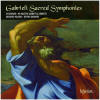Texte paru dans: / Appeared in:

Fanfare Magazine: 36:4 (03-04/2013)
Pour
s'abonner / Subscription information
Les abonnés à Fanfare Magazine ont accès aux archives du
magazine sur internet.
Subscribers to Fanfare Magazine have access to the archives of the magazine
on the net.
Hyperion
CDA67957

0034571179575 (ID268)
Consultez toutes les évaluations recensées pour ce cd
~~~~ Reach all the evaluations located for this CD
This is a celebratory album in more than one respect. There is the 400th anniversary of Giovanni Gabrieli’s death, in 1612, but His Majestys Sagbutts and Cornetts is also experiencing their 30th anniversary as a performing ensemble, and Concerto Palatino, their 25th. All these matters to one side, though, the album celebrates that varied, rich, and exuberant Venetian sound world Gabrieli was the most prominent exponent of, even though he didn’t create it. The musical language he espoused was stile moderno. It was an approach built upon the dramatic juxtaposition of opposites: much simplified counterpoint versus homophony, voices versus instruments (that assumed a new prominence), harmonically static passages versus sudden chromaticisms, and abrupt changes in rhythm, texture, and the composition of choruses. All of this was aimed at expanding the expressiveness of the music, whether to celebrate sacred texts, or the ceremonial splendor of the Venice that its political class wished to project to the world through his canzone and sonate.
Gabrieli worked these elements of his musical language with nuance and ingenuity. The drama is muted in the contemplation of the newborn King, O Jesu mi dulcissime, where a sensitive treatment of the text through interwoven contrapuntal lines, simple chords, and basic choral contrasts creates a rapt mood. The incantatory effect of the endlessly repeated ora pro nobis line conclusions in the lengthy Litaniae Beatae Mariae Virginis stands in direct contrast to their varied openings, building to a powerful finish. At the other end of the expressive scale is Omnes gentes plaudite manibus. Several commentators state that he never wrote in such lighter forms as the dance, but that is in error: This work and many others like it are permeated with dance measures. Presumably this is because Gabrieli realized exultant dancing is one of the few appropriate responses to the call to celebrate one’s God.
The performances throughout all 11 cuts are uniformly first rate. Jeffrey Skidmore’s Ex Cathedra is an excellent choice in music this expressive, where a constant exploration of dynamics, enunciation, and phrasing can yield much to treasure. (Not that the exquisite balance favored by English choirs is not lacking; the 1615 O Jesu mi dulcissime should put paid to that idea.) All three ensembles perform at a very high technical level, whether in massed groups or solos; stylistically well matched, and expertly led.
Hyperion’s recording team deserves a round of applause of their own for creating the perfect sound for all this. It couldn’t have been easy, given Gabrieli’s penchant for constant contrast. The venue and microphone setup provide strong balance, and the church-like ambiance gives spaciousness to the sound without softening the music’s edge. Highly recommended.
Cliquez l'un ou l'autre
bouton pour découvrir bien d'autres critiques de CD
Click either button for many other reviews


